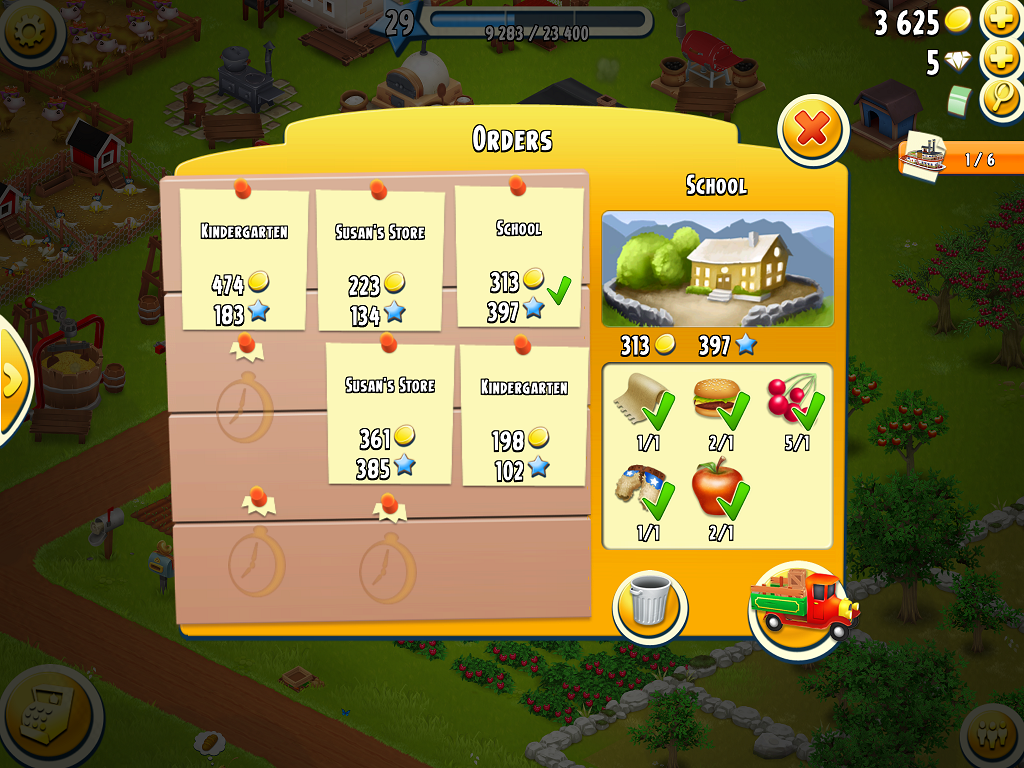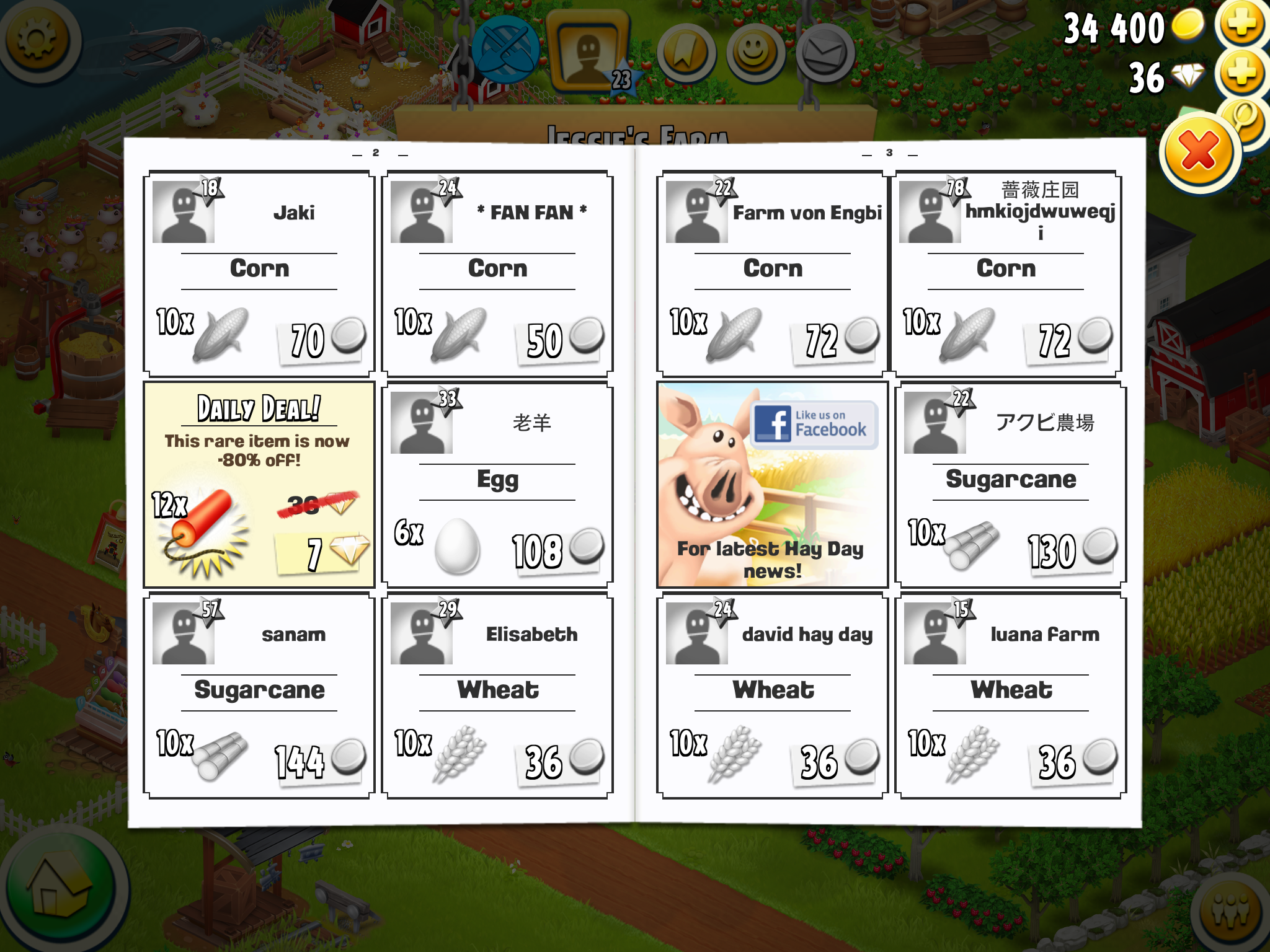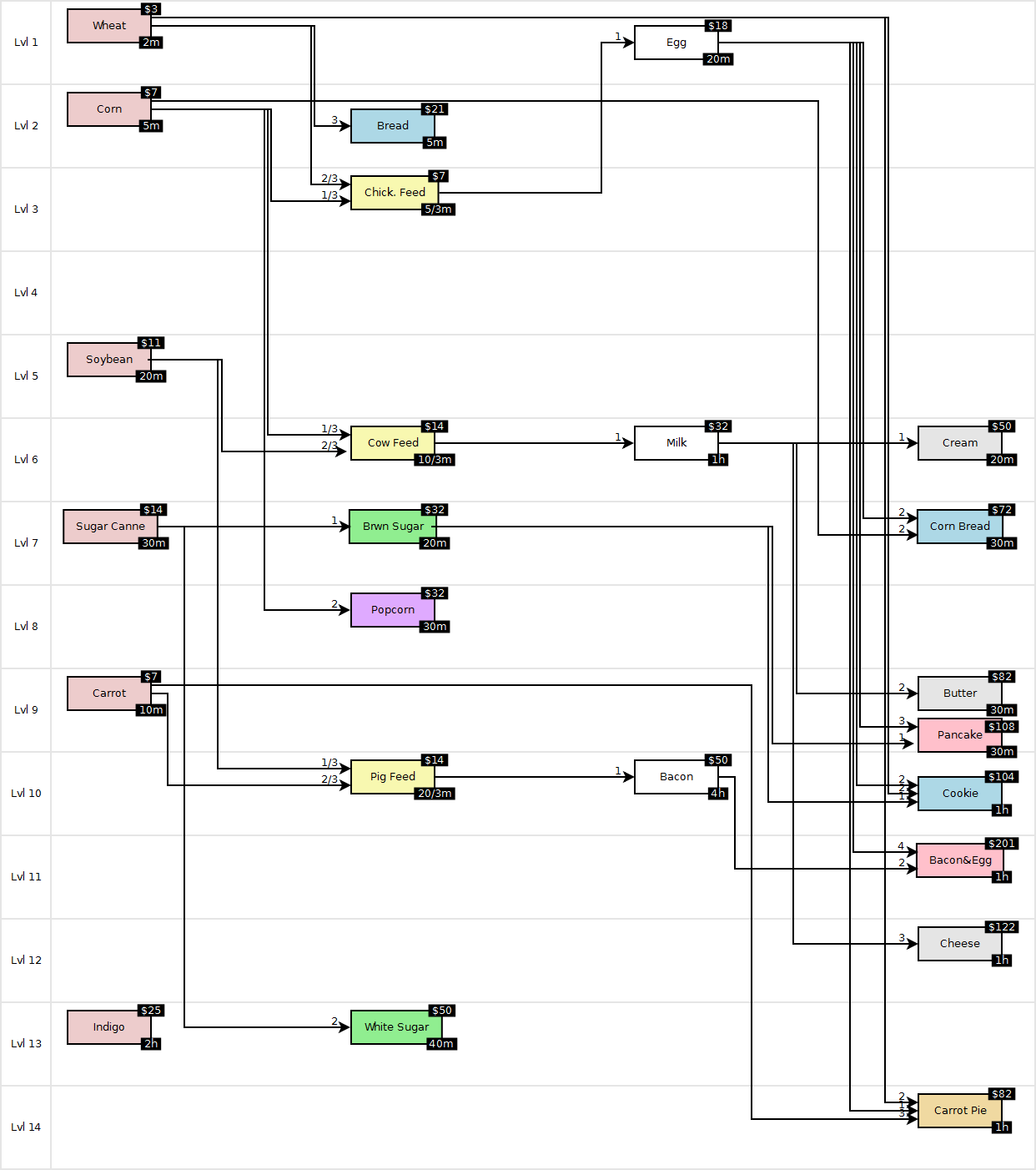Hay Day
Hay Day is a mobile free-to-play farming game released in Summer 2012 by Supercell. These are notes from 2015, when I played the game for a couple months. I first go over the core mechanic of the game, fulfilling orders. Then I cover two of its very constrained, yet elegantly-designed, multi-player interactions: the Daily Dirt newspaper and neighborhoods. Finally, I’ll have to mention some less elegant parts of the game: manipulative monetization, and grinding.
Fulfilling orders
To understand orders, we need to talk about currencies first: XP and gold. They go hand-in-hand:
- Gain XP to level up and unlock equipment (hen house, sugar mill).
- Spend gold to buy equipment unlocked from XP.
Fulfilling orders from the villagers is the main source of gold. Orders require:
- Crafting food or items (eg 1 hamburger)
- … from ingredients (2 bread + 2 bacon)
- … which are themselves crafted (3 wheat for 5 minutes at the bakery = 1 bread)
- … or harvested from animals (pig feed + 4h = 1 bacon)
- … which need to be fed (2 carrots + 1 pea = 3 bags og pig feed).

The mechanics are easy to understand, because the UI metaphor is self-explanatory. Fulfilling an order unpins it from the board, and immediately replaces it with another. Order rewards seem to increase logarithmically with the time required to produce their items. When players decide an order is not worth, they can discard it from the board without fulfilling it. To prevent abuse, discarding comes with a cooldown for the next order shows up.
After roughly a month of play, the player unlocks the boat and its bulk orders. Bulk orders require dozens of items and must be fulfilled within 16h, or the boat leaves empty. Other players can help though, to some extent (see neighborhoods below).
Daily Dirt newspaper
The Daily Dirt allows players to advertise items they want to sell to other random players. Three features prevent it from destroying the economy.
- Caps on item sell prices, eg 10 wheat can be sold for max $36, 10 sugar canes $144. Caps prevent 1) inflation, 2) F2P players acquiring a ton of gold and ruining the game for themselves.
- Only 54 ads are displayed (9 pages of 6 items), and there is no item search. This prevents whales from buying items on the player market for cheaper than from the base single-player game.
- Throttling: listings refresh every 2 minutes. This may actually also be an engineering constraint. I recall that it used to be 5 or 10 minutes. Note that the cooldown is client-side, so closing the app brings another newspaper.
Despite, or maybe because of these features, 70% of the items listed are wheat (see grinding section below). Still, heavy players browse it often, looking for rare items, even when max-priced. Were there no price caps, these items would cost a fortune, but with caps, it’s first-come first-serve.

Neighborhoods
They are basically guilds or clans. They allow neighbors to fulfill each other’s boat bulk orders. The cap at 2 or 3 per boat, however, prevents players from specializing in crafting only certain items.
Neighborhoods can also compete against 6-8 others in derbys. This was my experience back in 2015. Now in 2018, there are derby leagues and up to 15 competing neighborhoods per derby. I found the UI metaphor for the leaderboard very smart: a mechanical horse race. It makes the competition look casual, friendly, but still important.
Worldwide events
They happen monthly-ish, and involve the whole community for a few days. I participated in only one, but I can tell that: Any player can give any amount of the items requested. A leaderboard tracks the top donors, enticing whales.
Evil monetization tricks
Permanently floating on the right of the screen, below the currency HUD,
is a banner with a diamond, a %, and the text 57 min 47 sec.
Clicking on it opens a popup:
You were selected for a major discount!
130 diamonds for $1.99 instead of $4.99. -60%!
Time left: 57 min 47 sec.
<Purchase Now>
Back in 2015, some marketers did recommend creating a sense of urgency. This was and is still widespread among ecommerce and flight-booking sites. I think it’s manipulative, even by 2018 standards, and suspect it’s now widespread in mobile games too.
But I get it - games need to make money. I just find this way isn’t elegant. It feels tacked onto the game by a growth hacker, not well-thought-out by a game designer.
Grinding
Inventory space is super limited. Upgrading the barn with tools adds some, but tools are scarce at 1-1.5% drop per crop harvested. So players resort to Wheating: plant wheat on all available fields, wait 2 minutes (fastest crop), and harvest 1-2 tools.
This doesn’t feel great. I’m stuck with a ton of wheat crowding my inventory. I sell it for $1 in the newspaper, but it takes a while. The game is punishing me, maybe on purpose, so I should stop doing this. But I will do it again because it is the fastest way to grow my inventory!
Beginners are frustrated and don’t understand why the newspaper is full of wheat.
In the first place, inventory is scarce so players spend money to increase it. Fixing this problem means, I think, either hurting revenue or deploying a major change to core mechanics.
Appendix
See also this interview of Hay Day’s product lead.
This is a graph of crafting dependencies for the first 14 levels.
